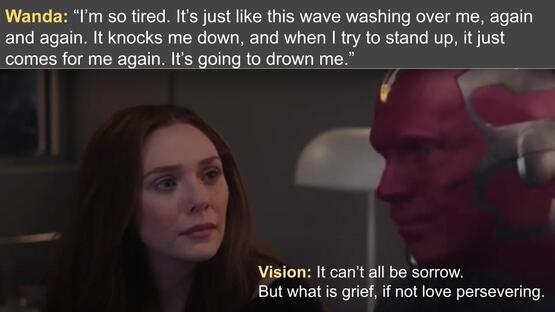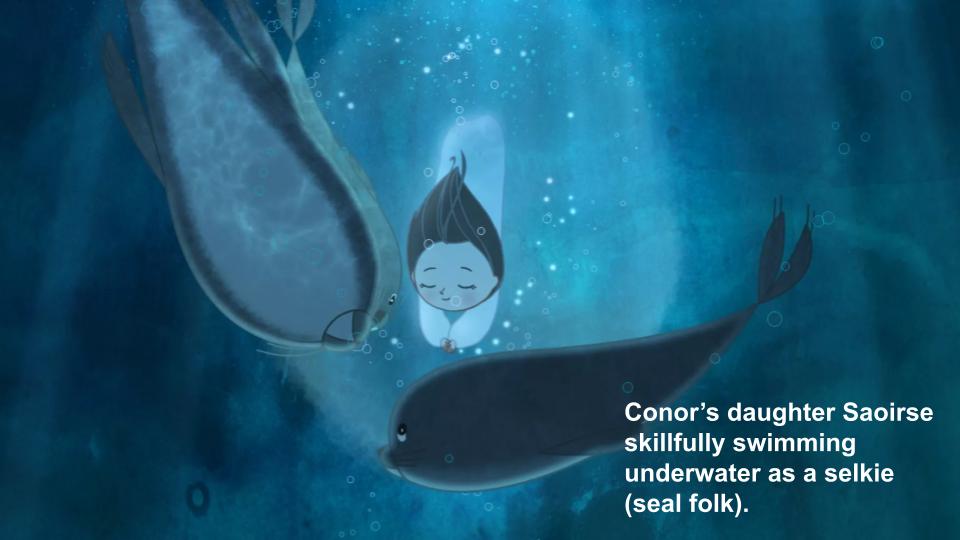|
An exploration of archetypes in complicated grief through two films: (1) WandaVision, and (2) Song of the Sea. #WandaVisionComplicatedGrief Introduction In the film "News of the World," Jefferson Kyle Kidd helps a young girl Johanna who has had so many losses and traumatic experiences. Kidd assures Johanna that their goal now is to journey forward and make new memories to replace the bad ones. But Johanna retorts: "To move forward you must remember first." Theologian Richard Rohr affirms this insight in his book Breathing Underwater when he writes: “You cannot heal what you do not first acknowledge.” Since, as English author Neil Gaiman points out,  The Challenge: First Two Tasks in Grief In my blog on “Being A Good Host to Our Grief,” I reflected on the second task of grief - which is about experiencing the pain of grief (theorized by William Worden). In grief work, many grief experts phrase this skill as “feeling our feelings” or gently “leaning into our grief.” This work is not easy. There are normal bumps and complications that take place on the grief journey - after all, grief is non-linear. It twists and turns. It is labyrinthine. You take three steps forward, then you take two steps back. It oscillates nonstop between symptoms of loss and symptoms of restoration. However, there are situations when the person journeying through grief may feel stuck. For some it may feel like a nightmare that won't let up. For others it is a long-term feeling of being drowned by one or all of the many common (and normal) grief symptoms: anger, guilt, depression, meaninglessness, denial. When stuckness happens, it is important to reach out to a professional grief counselor for support. It is not recommended to go through grief alone. This is the healthy way to move forward: journeying through it with a companion(s) who know the process, and can witness and validate your experience, and mentor/model for you how to wade the waters of grief.  The Controversy In the grief world, complicated grief is a controversial topic. Some experts consider complicated grief a disorder that must be diagnosed and fixed. Others, on the other hand, believe that this phenomenon is a normal process of grief. Critics of "complicated grief as pathology" perspective claim that it supports misinformed and antiquated notions that (a) grief symptoms are a type of sickness that must be problem-solved, and that (b) there is a grief timeline and a right way to grieve. While the caution of those who critique ideas of complicated grief as a type of pathology is warranted, I also think it is important to note, at a minimum, what causes grief to be complicated - specifically, the experience of being stuck. The root cause goes back to the first two of Worden’s tasks of grief: 1. accepting the reality of the death, and 2. feeling our feelings. (See the illustration of the TEAR Model of Grief above). The tendency to deny reality and avoiding painful feelings is a normal human tendency that we all do at some level. But avoiding these two tasks at all cost - that is, dodging the task of accepting the reality of the loss and feeling the pain of the loss is, I believe, what causes complicated grief. It is OK to be tentative, but we still have to give dipping our toes in the waters of grief a try in spite of our fears and discomforts. Sometimes we may not have a choice: whether we like it or not, the tsunami waves of grief will wash over us anyway and we find ourselves trying our best to keep our heads above water. Whatever the case may be, the skill of learning to be in relationship with the waters of grief (i.e., emotional self-regulation) is crucial. This skill can be learned from others, say, from the loving support of a counselor or therapist. The following films below explore complicated grief. I invite you to view these films to get a sense of complicated grief and its patterns. TASK #1: Wanda's Alternative Reality (WandaVision)Released by Disney Plus, this film tells the story about Wanda Maximoff (from the Avengers) and her unresolved grief, including the death of her loved one, Vision. In this film, Wanda creates an alternate reality, a fantasy land, which keeps her in denial and out of touch with the pain of her many losses. Eventually, she is able to articulate the cause of her hesitation to do the first task of grief, which is to accept the reality of the death of her loved ones. She is terrified of being drowned by her grief. Vision replies with a few words of comfort: “It can’t all be sorrow.” He ends by saying, “But what is grief, if not love persevering.” This conversation is planting a seed of a different perspective in Wanda’s mind, namely, the possibility that “talking about [her grief] would bring [her] comfort.” Wanda learns that in order to move on with her life, she has to dismantle her fantasy world and let go of it in order to be able to do the second task: to feel her grief. TASK #2: On Bottling Emotions (Song of the Sea)Directed & written by Tomm Moore, the beautifully animated story of grief revolves around the family of a lighthouse keeper. After Conor’s wife dies, he avoids the task of feeling his pain. On the anniversary of his wife’s death, he goes to the pub to self-medicate his grief. The belief in avoiding grief at all cost is embodied by Conor’s mom “Granny” and Macha the Witch. To Granny & Macha, venturing into the sea or waters of grief is unsafe. The goal is to prevent those “terrible feelings” from “bubbling up”- one must bottle them up because these “nasty things” are “sick,” can “control you” and make you “feel so awful.” In this view, staying asleep from our pain by hardening our hearts into stone is “peaceful.” When Conor's son Ben realizes Macha's lie that by bottling up one’s pain “it will never hurt again,” he exclaims: “No, it doesn’t help at all. It just makes things worse.” Leaning into our grief is a skill. It is about learning how to swim and wade without fear of being controlled by them, without the fear of drowning (like Wanda). In the end, what liberates Conor's family from feeling trapped is music through the magical shell given by Conor’s wife to her kids. The shell allowed them to sing the song of the sea. They are able to remember her through story and song, giving them the gift of wading and swimming into the waters. CONCLUSION
To close, the characteristics of someone with complicated grief include one or both of the following: (1) The desire to create an alternative reality that is not congruent with the reality of the loss. This human impulse, embodied by Wanda (in WandaVision) goes against Worden's task number one. Complicated grief also includes (2) the belief, held strongly by Conor and Macha (in Song of the Sea), in bottling up one's grief by making feelings and emotions suspect; here, emotions are not safe. This view prevents the griever from doing task number two of Worden's Tasks of Grief. These two actions cause the griever to feel stuck in their grief journey. Thus, getting unstuck requires one (like Wanda) to face one's fear of drowning in the sea of grief, and develop skills to open up oneself to be in relationship with one's feelings (gently leaning into grief) and learn to wade and swim in it.
Charlotte
8/15/2022 05:45:29 pm
So much escapism peppered in, I appreciate this entire post! I want to share a great inspiration, when it comes to my own self discovery and unlocking infinite human potential. "Leap of Faith Wellness". https://leapoffaithwellness.com.au They excel so much in amazing materials and tell stories that tackle about all types of human struggles, and how self-development can help to solve them. Thanks again! Comments are closed.
|
Donnel Miller-MutiaJoin me in chewing the cud on mindful communication and relationships, self-awareness, spirituality and mythology. Archives
May 2024
Categories |
Proudly powered by Weebly






 RSS Feed
RSS Feed
